- Visibility 170 Views
- Downloads 12 Downloads
- DOI 10.18231/j.jdpo.2020.082
-
CrossMark
- Citation
A study on awareness of hospital acquired infections amongst undergraduate medical students in a tertiary care centre
- Author Details:
-
Priyanka Agarwal
-
Nitesh Mohan *
Introduction
Infection control and hospital acquired infections (HAI) prevalence reports from tertiary care centres are not well established because of lack of staff and resources.[1] Knowledge about the real frequency of nosocomial infections is an important prerequisite for improving hygienic conditions in hospitals. Health care associated infections (HAI) are those infections that the patient acquires while receiving health care. [2]
The prevalence of infective diseases is increasing in medical college students due to less immunity developing in them. [3] Their living in hostel or as day scholars away from home is reflected upon their dietary habit, which further adds to the chances of acquiring oral and gastrointestinal infections. [4]
Hospital acquired infections are spread by numerous routes including contact, intravenous routes, air, water, oral routes, and through surgery. The most common types of infections in hospital include urinary tract infections (32%), surgical site infections (22%), pneumonia (15%), and bloodstream infections (14%). The most common microorganisms associated with the types of infections are Esherichila coli, Enterococcus species, Staphylococcus auerus, Coagulase-negative staphylococci, or Pseudomonas aeruginosa. (secondary) Urinary tract infections occur when one or more of microorganisms enter the urinary system and affect the bladder and/or the kidneys. [5]
Needlestick injuries, which lead to the transmission of viral infestations like Hepatitis B, Hepatitis C, and HIV virus, are a potentially serious threat to students during their clinical postings. Exposure to infectious disease patient’s blood, and hazardous body fluids is one of the most frequently reported injury events by medical students at a health science center. [6]
The undergraduate medical education is the formative phase and appropriates moment for acquiring the necessary knowledge and skills. There is lack of evidence regarding explicit infection control training in the curriculum of most medical undergraduate courses, which needs to be assessed. [7]
This study was undertaken to assess the knowledge, awareness and attitude of the medical students toward basic infection control practices, such as standard precautions, hand hygiene, respiratory hygiene, cough etiquette, tuberculosis control, use of personal protective modalities, and the learning of approaches that help improve their knowledge and practices.
Review of Literature
Robert Weinstein et al.[8] in their comparative study on nosocomial infections at present and in the past, showed that there had been a reduction in number of cases of nosocomial infections, however the numbers of death were still high. According to them poor hygiene standards in most health centers have contributed to this. Cases of medical practitioners overlooking basic hygienic measures such as a proper hand washing when attending to patients was one of the common cause. They observed some medical services like injections were not administered in a proper manner. This is due to unqualified medical expertise especially in small health care centers which lead to infections.
Tony rizzo et al. in their research observed respiratory procedures, intravenous (IV) procedures, surgery and wound and urinary bladder catheterization as the common types of infections acquired in hospital. They said that most hospital-acquired UTIs happen after urinary catheterization. A catheter picks up bacteria that may be in or around the urethra and take them up into the bladder hence infecting it.
Jessica Lietz et al. in their research on nosocomial infections with emphasis on the causes and preventive measures for the infections observed that, there were higher rates of infections in public hospitals as compared to private health centers. They showed lack of adequate public education on the infections was a key factor in the spread of infections. For instance one may visit a patient suffering from an air borne disease and contact the disease without knowing. Similarly patients may share personal items such as towels, not knowing that they are subjecting themselves to harmful infections. They thought enlightening the public in general on the dangers of these infections and the basic control measures like maintaining a high personal hygiene can go a greater mile in trying to control these infections.
Sheetal Sharma et al.[9] In their research on health system infection control measure in developing countries ,highlighted three overarching lessons related to infection control and maternal mortality Dreduction. despite limited evidence on effective infection control measures during labour and delivery and from low resource settings, it appears that education, surveillance, organisational change and quality improvement interventions should be introduced, confirming the need for a health systems approach to reduce maternal mortality, especially in relation to sepsis. There is the need to improve our understanding of organisational and behavioural change to effectively implement infection control measures. Finally, globalized, targeted health policies or initiatives have the potential to bring attention to, and catalyse action for what is currently a neglected, but important cause of maternal death worldwide.
Savanthe AM et al [10] observed that knowledge of the medical students regarding infection source is adequate but infection prevention practices was relatively less particularly needle stick injury prevention, hand hygiene techniques, blood borne infection control. Hospitals should reinforce the knowledge of universal precaution continually and recommended performing infection control education programs at the college level before starting the clinical practice years along with seminars and feedback, highlighting importance of IPC guidelines to increase safety of our graduates and patients. Education should be enhanced by peers, seniors, and HCWs by acting as role models of infection control.
Aim
To study the awareness of hospital acquired infections amongst undergraduate medical students and to determine the underlying common causative factors.
Objectives
To determine the awareness of infections amongst medical students in relation to hospital and its preventive measures.
To find out the causative factors leading to these infections in undergraduate medical students.
To assess knowledge of medical students on infection control policy and procedures.
Materials and Methods
The present study is a cross-sectional study. Approval was taken from the Institutional Ethics Committee (IEC) of Rohilkhand Medical College & Hospital, Bareilly before commencement of study. Informed consent was obtained prior to the study participation.
Study population
The population of the study comprised of undergraduate medical students of Rohilkhand Medical College & Hospital, Bareilly.
Inclusion criteria
All MBBS students of our medical college who voluntarily participated in the study.
Exclusion criteria
All the students who have completed their internship and those who were not willing to participate in the study.
Study tool
The study was done using pre-coded, predesigned, closed-end online questionnaire which covered the following-
Regarding the variables: Knowledge of common infections acquired in the hospital, common route of acquiring these infections, common causative factors leading to infections, knowledge of preventive measures and associated control policy.
Information regarding:
Attitude of medical students towards common acquired hospital infections.
Knowledge of common routes of acquiring infections.
Knowledge of measures to prevent common infections.
Awareness of importance of precautions and cleanliness against hospital infections.
Methodology
A cross sectional study was conducted in Rohilkhand Medical College & Hospital, Bareilly on students of MBBS course. The sampling was done using convenient sampling. The identity of the study participants were kept confidential and anonymous. The survey was done online using a pre-coded, pre-designed, close end questionnaire which mainly focussed on the information about awareness of acquiring hospital based infections.
Data collection
Questionnaire data was collected online via Google forms.
Data analysis
Data analysis was done by using MS EXCEL and SPSS 25.0.
Implications
The study gave an idea of prevailing infections amongst medical students and common routes of entry. This will help in further planning of proper control measures to curb these, so as to reduce the prevalence of hospital acquired infections amongst medical students.
Results
A total of three hundred twenty students were invited to fill the questionnaire. Out of these, 250 medical students responded to the survey. Most students were in the age group of 21-25yrs -(66.8%), followed by 15-20yrs (28%). A total of 205 students (82%) were aware about hospital acquired infections while the rest were either uncertain or unaware.
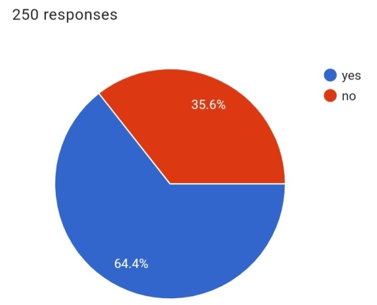
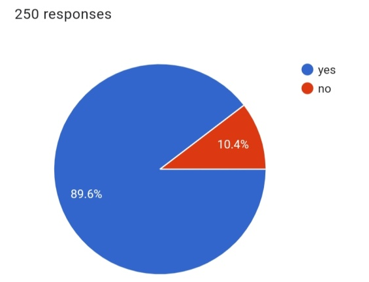
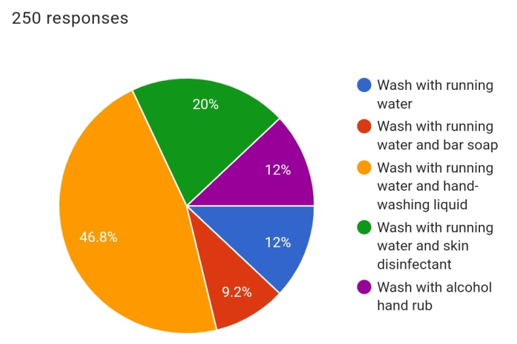
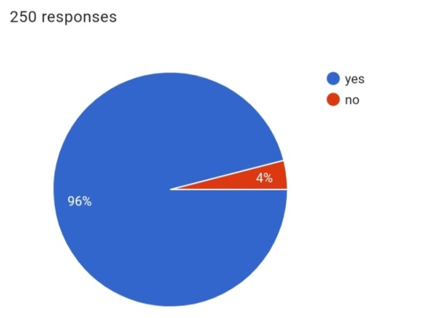
235 students (94%) strongly believe that health care workers are at risk of acquiring nosocomial infections though only (68%) had formal training in Hand Hygiene & Control against infections. Hand hygiene is an important health care measure to reduce hospital acquired infections & most hospitals have Infection Control policy as standard protocol for implementation.
There were mixed responses on various hand hygiene measures. 90.8% agreed that they use disinfectants when in contact with patients, while only (51.2%) used gloves. Alcohol hand rub was more commonly used (72.8%). Approximately (10.4%-18.4%) students were found to be not following the various dress codes protocols for prevention (details in diagram).
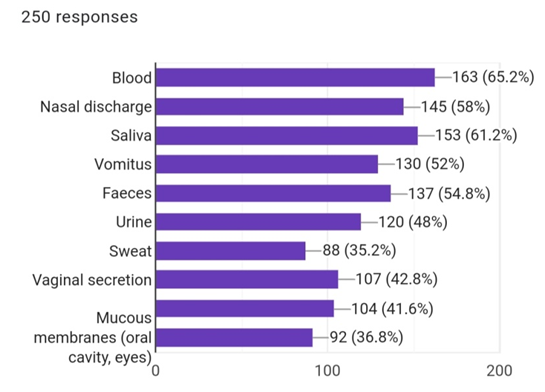
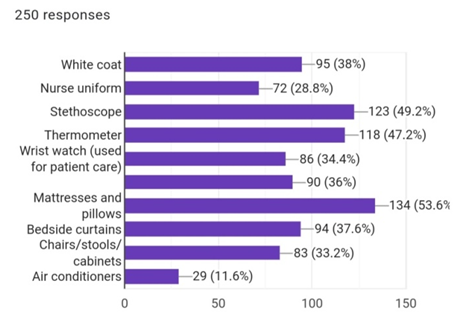
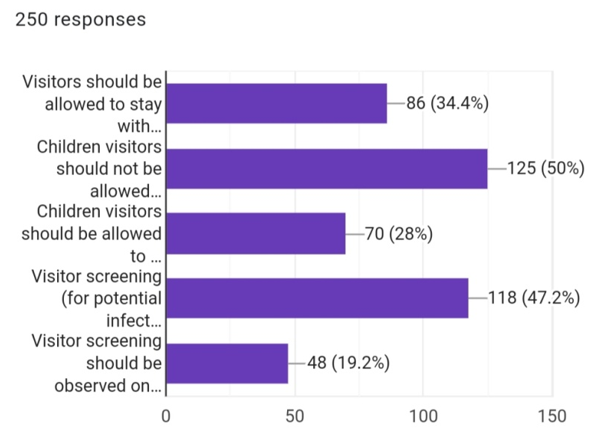
Discussion
Nosocomial infections are an important health issue globally and exposure to infectious diseases is a frequently identified occupational hazard faced by medical students.
Preventive measures for such infections through adequate knowledge and awareness are important requirements for all medical students.
In this prospective study on 250 medical students of Rohilkhand Medical College and Hospital, we explored students’ knowledge and awareness by using a question based survey. The response rate of the students was 78% as not all of them responded to questionnaire. There were some wrong answers for some of the questions showing presence of defects in their knowledge. Our results showed that 82% of students are aware of hospital acquired infections and their preventive measures, which include proper hand hygiene, safety during contact with patients and safe use and disposal of sharps.[b] Other study by Ibrahim AA. et al. showed a low awareness (48.44%)c, while study by Kadi AA. et al. showed 57.1% average awareness. An increased rate in our country might be due to various awareness programs and advertisements through government policies.
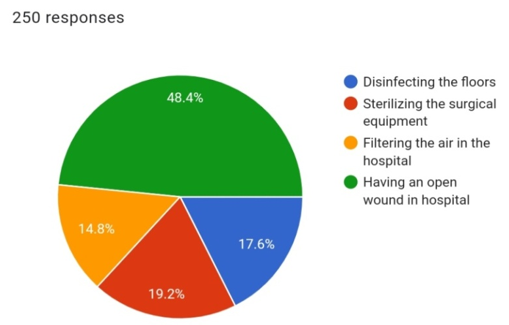
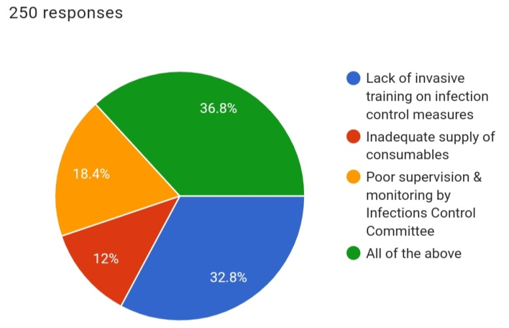
Hand hygiene forms a major preventive measure in control of nocosomial infections. Our medical students were aware of washing hands before and after contact with patients (90.8%) and used gloves everytime (51.2%). Less number of students may be using gloves because of financial constraints. Kadi AA et al. in their study also showed (36-41.5%) of students using gloves. We recommend training students on importance of hand hygiene through proper teaching methodology.
We observed that amongst common causes, patients with open wound are a frequent source of infection to medical students followed by unsterile surgical equipments and dirty hospital floors.
A large percentage (68%) of our medical students had a desire for formal training for prevention of nosocomial infections. This was also observed by Zahrani SA et al in their study (78.5%) this indicates importance of implementation of continuous training through infection control policy for all medical students in health care workers. Better strategies should be planned and implemented against nosocomial infections. Though a good number of students were aware of about existing infection control policy in the hospital (75.6%) but lack of invasive training (32.8%) in adequate supply of consumables (12%), poor supervision and monitoring by Control Committee (18.4%), or all these factors combined (36.8%) were all -together causing high prevalence of hospital acquired infections.
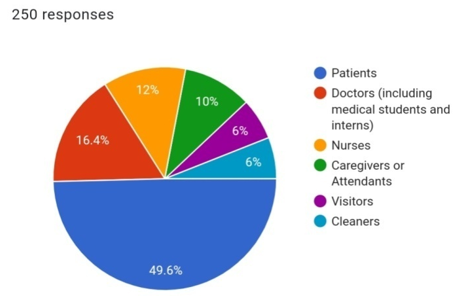
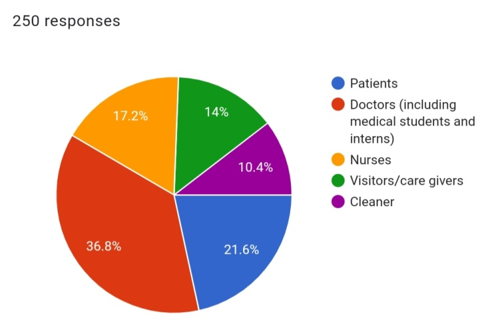
Many studies have analysed health care workers at risk to these infections our observations show that doctors including medical students and interns (36.8%) are at maximum risk, followed by near -by patients (21.6%), nurses (17.2%), and visitors & patient attendants (14%).Hospital cleaning staff are also at risk of acquiring various infections. Therefore medical university should take necessary action to inform, educate and vaccinate the health care workers who may be at risk. Vaccination against viral infection should be made mandatory for all health professionals.
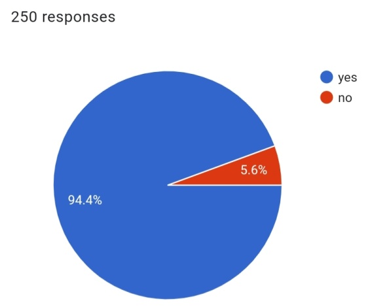
Source of Funding
No financial support was received for the work within this manuscript.
Conflict of Interest
The authors declare they have no conflict of interest.
References
- I Jroundi, I Khoundri, A Azzouzi. Prevalence of hospital acquired infection in a Moroccan university hospital. Am J Inf Cont 2009. [Google Scholar]
- H. Rüden, P. Gastmeier, F. D. Daschner, M. Schumacher. Nosocomial and community-acquired infections in Germany. Summary of the results of the first national prevalence study (NIDEP). Infection 1997. [Google Scholar] [Crossref]
- A K Srivastava, Sd Kandpal, Abha Ks Negi, Srivastava. Prevalence and risk factors of hypertension among medical college students, hiims, dehradun. Indian J. Prev. Soc. Med 2012. [Google Scholar]
- P Sachin, S Arun. A cross sectional study of nutritional anaemia among medical students in a medical college. National J Med. Sci 2013. [Google Scholar]
- L Curtis. Prevention of hospital-acquired infections: review of non-pharmacological interventions. Journal of Hospital Infection 2008. [Google Scholar]
- K Calabro, A Weltge, S Parnell, K Kouzekanani, E Ramirez. Intervention for medical students: Effective infection control. Am J Infect Control 1998. [Google Scholar] [Crossref]
- AI Awab, SE Sittana. Knowledge, awareness, and attitude regarding infection prevention and control among medical students: a call for educational intervention. Adv Med Ed Prac 2016. [Google Scholar] [Crossref]
- UK Essays. Nosocomial Infections: Literature Review . 2018. [Google Scholar]
- J Hussein, DV Mavalankar, S Sharma, L D'Ambruoso. A review of health system infection control measures in developing countries: what can be learned to reduce maternal mortality. Globalization and Health 2011. [Google Scholar]
- AM Savanthe, CS Savolu. Awareness of risk of infections to health care professionals and its preventive practices among medical students: a cross-sectional study. Int J Community Med Public Health 2018. [Google Scholar] [Crossref]
